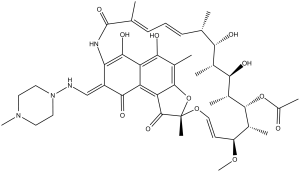This product is for research use only, not for human use. We do not sell to patients.

| Size | Price | Stock |
|---|---|---|
| 10g | $300 | Check With Us |
| 50g | $550 | Check With Us |
| 100g | $825 | Check With Us |
Cat #: V1468 CAS #: 13292-46-1 Purity ≥ 98%
Description: Rifampin (Rimactane; Arficin; Arzide; Rifampicin; Rifadin; Rimactane; Rimactan; Tubocin; Archidyn; Benemicin; Doloresum; Eremfat; Fenampicin; Sinerdol), an approved broad spectrum and semisynthetic antibiotic found in Streptomyces mediterranei, is mainly used to treat various bacterial infections such as TB-tuberculosis, leprosy, mycobacterium avium complex, and Legionnaires' disease.
Publications Citing InvivoChem Products
Product Promise

- Physicochemical and Storage Information
- Protocol
- Related Biological Data
- Stock Solution Preparation
- Quality Control Documentation
| Molecular Weight (MW) | 822.94 |
|---|---|
| Molecular Formula | C43H58N4O12 |
| CAS No. | 13292-46-1 |
| Storage | -20℃ for 3 years in powder formr |
| -80℃ for 2 years in solvent | |
| Solubility In Vitro | DMSO: 100 mg/mL (121.5 mM)r |
| Water: <1 mg/mLr | |
| Ethanol: <1 mg/mL | |
| Synonyms | Rimactane; Arficin; Arzide; Rifampicin; Rifadin; Rifampin; Rimactane; Rimactan; Tubocin; Archidyn; Benemicin; Doloresum; Eremfat; Fenampicin; Sinerdol; |
| Protocol | In Vitro | Rifampicin (100 mg/mL) can block the functional activity of P-glycoprotein. Rifampicin is not a substract for P-glycoprotein. The mechanism of rifampicin resistance is unassociated with the functional activity of P-glycoprotein |
|---|
| Solvent volume to be added | Mass (the weight of a compound) | |||
|---|---|---|---|---|
| Mother liquor concentration | 1mg | 5mg | 10mg | 20mg |
| 1mM | 1.2152 mL | 6.0758 mL | 12.1516 mL | 24.3031 mL |
| 5mM | 0.2430 mL | 1.2152 mL | 2.4303 mL | 4.8606 mL |
| 10mM | 0.1215 mL | 0.6076 mL | 1.2152 mL | 2.4303 mL |
| 20mM | 0.0608 mL | 0.3038 mL | 0.6076 mL | 1.2152 mL |
This equation is commonly abbreviated as: C1 V1 = C2 V2
- (1) Please be sure that the solution is clear before the addition of next solvent. Dissolution methods like vortex, ultrasound or warming and heat may be used to aid dissolving.
- (2) Be sure to add the solvent(s) in order.




































